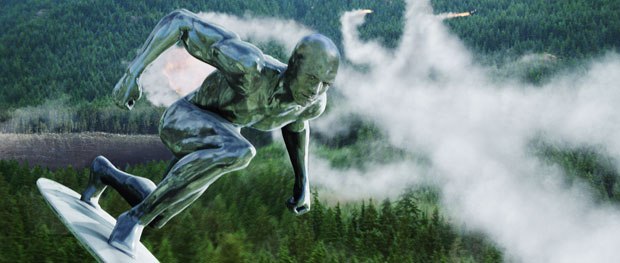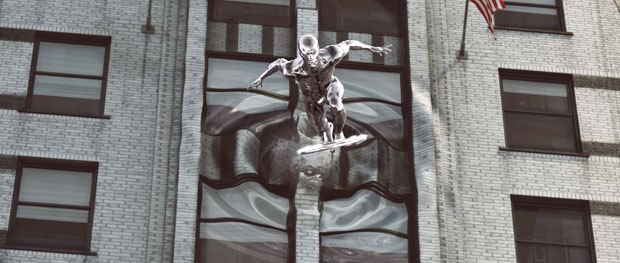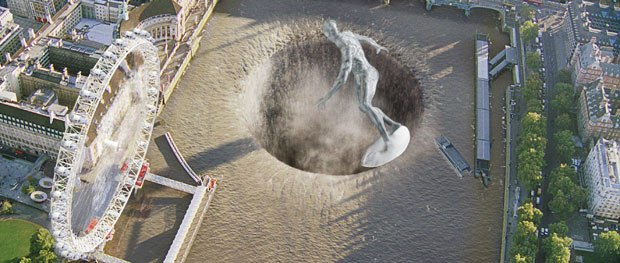Weta Digital creates a unique, liquid shine for Silver Surfer in the Fantastic 4 sequel, and Thomas J. McLean goes behind-the-scenes to find out how.
Comicbook movies are unique for the opportunity to bring to life iconic characters that have often existed only on the page for decades. Such was the case with the Silver Surfer, a beloved fixture of Marvel Comics since 1966, who has at long last come to the big screen in Fox's Fantastic 4: Rise of the Silver Surfer, courtesy of New Zealand-based Weta Digital.
The biggest challenge facing Weta was time. Vfx supervisor Eric Saindon says the shop landed the job in late 2006, but didn't have plates until the end of January. With a deadline of April 20 to complete around 300 shots, the schedule was especially tight given the diversity of effects the 110-member crew had to complete.
"In this movie, it seemed like every sequence had completely different effects, so it was a lot of R&D time for such a short turnaround," Saindon says.
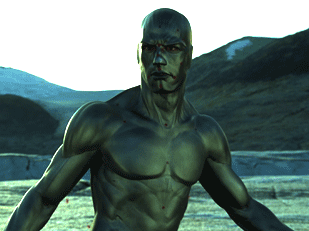
The crew began by visiting a Wellington comicbook store and snapping up every Silver Surfer story they could get their hands on. After selecting the best poses and figure out what would work for film, they decided the character, played on set by actor Doug Jones, would need to be completely CG.
"When we first came on in December, the thought at the time was they were going to use Doug as the on-set Surfer using a suit and possibly doing an effect to it, something like they'd done on the first film with The Thing," Saindon offers. "But I think pretty early on they figured out that this wasn't going to work to really get this dynamic character, to really bring him to life and work well for the film."
Keeping it Real
Even though Jones was to be completely replaced with a digital performance, Weta requested that the actor be on the set to work with director Tim Story and the other actors.
"We've learned on other movies that it's much easier to paint out a character who is on set and put something over the top of them than to try to make bad acting from another actor work with a clean plate," Saindon continues.
Jones wore a rubber suit that roughly resembled the Surfer and had markers on it. Weta used multiple cameras on set to gather reference that were used in conjunction with 3D-Equalizer to get very quick matchmoves from Jones that the animators could work with.
"This didn't work in all cases, because the Surfer is floating on the board and moving through these scenes in much different ways than Doug could, but it was a good starting point for the performance," Saindon explains.
The performance morphed during the animation process, usually away from what Jones did on set, sometimes in major ways and sometimes in subtle ways. Weta worked closely with Story, consulting him almost daily and sending over rough sequences as quickly as possible to ensure the edit was working.
Additionally, Story directed some motion capture on a stage with a stunt double to try to capture some of the Surfer's iconic comicbook poses. "We just dispersed those wherever we needed them," says Saindon. "We used those as a library really."

A Shine for the Surfer
Reflective characters were among the first CG creations, so creating a different look for the Silver Surfer was a key priority. "That was one of the biggest worries of the entire thing, was we didn't want to do another Terminator 2," says Saindon.
Weta used a lot of shader tricks to achieve the final look of the character, creating a look that was slightly liquid looking and less chrome-like. Saindon says among the tricks they used were tweaking the contrast differences and using occlusion to make the character not shine so much in some areas. They also had to add reflections of his own body for shots in which his arm passed against his torso.
New software written by Simon Clutterbuck helped improve the look of the Surfer's skin, providing proper volumetric skin preservation and better handling of wrinkles. "It's a very efficient and proper way to do skinning that gets much better detail and you can save on resolution because it's very smart about the way it looks at the vertices and does the skinning," Saindon adds.
The crew also spent a lot of time collecting lighting info from the set, using 8mm lenses and shooting environment maps that were assembled in Nuke. The Surfer's board is another key part of the character, and it was something the Weta crew played around with a lot. "Early on, they wanted the board to be leaving a trail, so we did a lot of different wakes that this thing would leave," Saindon suggests. Inserting the board into plates of Jones standing on a small blue platform was fairly straight forward, with its liquid look coming again from shaders.
The shop developed a procedural technique for creating the ripples of energy that emanate from the Surfer himself.
Shaping the World Eater
Weta also worked on Galactus, surely the most controversial part of the film for Marvel fans. In the original comicbooks, Galactus was a 30-foot giant clad in purple and blue armor with a distinctive helmet. Saindon says the studio wanted a different approach and asked Weta for concept designs based on the idea of Galactus as a giant storm. "They wanted something that was a bit discrete and wasn't a big focus for the movie," he says.
Rough sketches evolved into an idea for a structure engulfed in atmosphere and mist, with a lot of tinkering with color palettes and deep shadows to get an interesting look. The final version was animated, with some parts done by hand and others using procedural techniques.
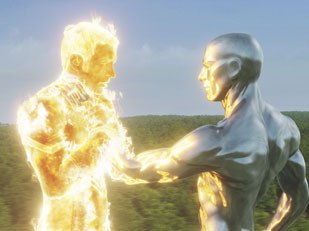
Lead td Allen Hemberger came up with a way to render Galactus using millions of particles, but it was a process that required a lot of manpower to finish, Saindon says. Eagle-eyed viewers will spot hints of the comicbook Galactus lurking in the cloud. "We do the helmet in there some, you see it below the surface on a few shots," Saindon says. "It took us a lot of convincing to get that in there."
New Tools and Old
Weta's other sequences included the chase through China and the battle between the villainous Doctor Doom and the heroes in their Fantasticar. Saindon says some greenscreen footage was shot of Doom, but they ended up doing a full CG version to ensure that cloth and wind was consistent. More challenging was creating "über-Johnny," in a scene where Johnny Storm absorbs the powers of his teammates to defeat Doom.
"It was hard to make him look like he had the combined powers," admits Saindon. "Fire kind of overwhelms everything so quickly that once you light him on fire you can't tell that he has the other powers. There was a lot of back and forth on that one in concept work to really come up with something that worked as a character."
Most of the tools used on the film are standard, such as Maya, RenderMan, Shake and Nuke, though new techniques were used and new systems tested out on the film. Weta used a curve fire system to create Johnny's flame. The system creates hairs on the character's body that are given a fluid fire texture, allowing large areas to be filled with fire quickly without full fluid simulations and improving render times.
Weta used the Blast Code system it had used on King Kong to create the buildings for Johnny and Doom's final battle in Shanghai. They also had to recreate the countryside of China and the Great Wall. Saindon says the Santa Monica Mountains stood in for the wall, with Weta painting out the city and coast line and filling it with trees. That provided a good opportunity for Weta to test a new environmental system for building trees and digital forests.
"It was a good movie for testing a lot of new things that we are going to use on more movies coming up," he concludes.
Thomas J. McLean is a freelance journalist whose articles have appeared in Variety, Below the Line, Animation Magazine and Publishers Weekly. He writes a comicbook blog for Variety.com called Bags and Boards, and is the author of Mutant Cinema: The X-Men Trilogy from Comics to Screen, forthcoming from Sequart.com Books.
